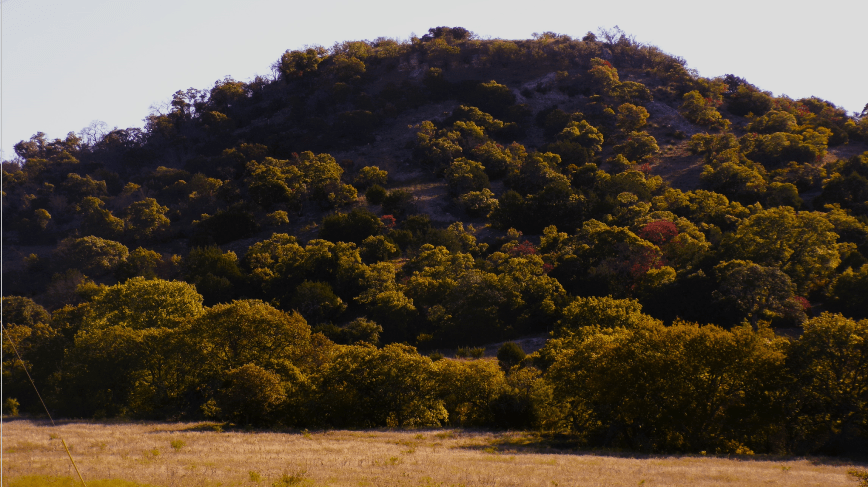
In the brushy hills five miles northwest of Blanket, Salt Mountain stands silently against a gathering sunset. This lonely rise of rock, juniper and cactus, and yes some salt, has a storied history in the annals of Texas as one of the most frequent sites for battles between Comanches and Anglo settlers. Deer and antelope were attracted to the salt licks on the mountain, perhaps making it a desirable hunting spot for both Comanche and settlers alike. Quite a few people met a violent end here on and near this mountain, so perhaps it is true that Salt Mountain has a few ghosts still hanging around it to this day.
Situated along one of two main trails used by Native Americans in the 19th century to traverse the increasingly settled area of Brown County, the hill is one in a series of outcroppings found in the Blanket area. “There were two main trails by which the Comanches entered the county. One of these was through Mercer’s Gap, running along toward what later became known as Salt Mountain, and continued toward the east and northwest up Pecan Bayou and on into Callahan county,” records James White in his Brown County history, The Promised Land.
“Salt Mountain is a little mountain on the east side of Brown County, about five miles from the upper line of Comanche county” wrote FM Cross in his book, Early Days in Central Texas. “It was the most noted place for Indian fighting in the state. From the time this country began to be settled until the Indians were driven out entirely, there were several fights on or near this mountain.”
According to Cross, the first recorded battle between Comanche and the settlers at Salt Mountain took place sometime around 1854, when members of the Mullins family pursued a band of Comanche that had stolen some horses in Mills County. “When the boys saw where they had started with the horses, they saddled some others and took the trail. Being well mounted, they soon came in sight of the Indians. There were only three of the boys after them, but they left the stolen horses and pulled for the thickets of Salt Mountain.” One Comanche was shot and killed during this skirmish, marking the first of several casualties recorded at the mountain. This warrior reportedly had a chain of Mexican coins dangling from his hair that was nearly long enough to reach the ground.
Indian Depredations in Texas, by J.W. Wilbarger recorded another fight at Salt Mountain circa 1859, this time between a group of settlers from Comanche County and a band of Comanche raiders. The raiders had killed two ranchers in Coryell county, then divided into 3 groups to outsmart their pursuers. “One squad passed up the Leon Valley, one up Cow House Creek, and one up Lampassas river, and were to come together at Salt Creek Mountain, some thirty miles west of the town of Comanche, in the northwest part of Brown County. The squad that passed up the Leon Valley was discovered late one evening by the mail carrier en route to Brownwood, as they were passing Mercer’s Gap. Fortunately for the mail carrier, he was not discovered by the Indians, and seven miles back to Elisha Barcroft’s, the nearest house, he returned as fast as a mule under spur and quirt could travel, arriving at Barcroft’s just after dark, with barely enough breath left to detail the facts,” the story goes. Two Comanches were killed in this fight, with several of the Anglos injured as well. The other two bands that split up and headed to Salt Mountain were not apprehended.
Yet another incident took place at Salt Mountain in 1858. A family named Jackson was massacred in southwestern Brown county. The husband, wife and 4 children were killed while gathering pecans near Pecan Bayou. Two other children were carried away by the Comanche. A quickly gathered posse set out to pursue the kidnappers, finding the children abandoned yet alive near Salt Mountain, according to The Promised Land account.
With so many interesting battles and incidents taking place at Salt Mountain, I am sort of surprised no historical marker has been placed at the site. Perhaps any restless souls out there on the hill would be more content if the site of their final moments were memorialized for future generations. Comanche Chief Quanah Parker reportedly said in one of his last speeches, at a Texas State Fair, “I challenge you to go forth and tell Texas history straight up.” Marking a spot like Salt Mountain as a place where historic events took place makes it easier for people to access and appreciate local history, and maybe that contributes a bit to what Parker envisioned in his admonition not to tell the stories from yesterday that built our today.
***
Diane Adams is a local journalist whose columns appear Thursdays on BrownwoodNews.com
